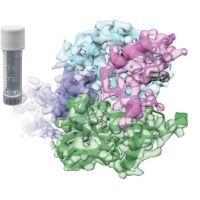Specification
| Description | Recombinant protein from the full-length sequence of Homo sapiens elongin B (ELOB), transcript variant 2 (NM_207013). |
| Organism | Homo sapiens (Human) |
| Expression Host | Human Cells |
| Tag Info | His or DYKDDDDK. Please contact us if you need further information or require specific designed tag. |
| Purity | Greater than 90% by SDS-PAGE gel |
| Uniprot ID | Q15370 |
| Entry Name | ELOB_HUMAN |
| Gene Names | ELOB TCEB2 |
| Alternative Gene Names | TCEB2 |
| Alternative Protein Names | Elongin-B (EloB) (Elongin 18 kDa subunit) (RNA polymerase II transcription factor SIII subunit B) (SIII p18) (Transcription elongation factor B polypeptide 2) |
| Application | Antigens, Western, ELISA and other in vitro binding or in vivo functional assays, and protein-protein interaction studies; For research & development use only! |
| Buffer | Purified protein formulated in a sterile solution of PBS buffer, pH7.2, without any preservatives |
| Endotoxin | Endotoxin level is < 0.1 ng/µg of protein (<1EU /µg) |
| Length | 118 |
| Molecular Weight(Da) | 13133 |
| Protein Sequence | (The sequence of expressed protein may have some variation from the sequence shown below. Please contact us for the exact sequence.) MDVFLMIRRHKTTIFTDAKESSTVFELKRIVEGILKRPPDEQRLYKDDQLLDDGKTLGECGFTSQTARPQAPATVGLAFRADDTFEALCIEPFSSPPELPDVMKPQDSGSSANEQAVQ |
Background
| Function | FUNCTION: SIII, also known as elongin, is a general transcription elongation factor that increases the RNA polymerase II transcription elongation past template-encoded arresting sites. Subunit A is transcriptionally active and its transcription activity is strongly enhanced by binding to the dimeric complex of the SIII regulatory subunits B and C (elongin BC complex) (PubMed:7638163). In embryonic stem cells, the elongin BC complex is recruited by EPOP to Polycomb group (PcG) target genes in order generate genomic region that display both active and repressive chromatin properties, an important feature of pluripotent stem cells (By similarity). {ECO:0000250|UniProtKB:P62869, ECO:0000269|PubMed:7638163}.; FUNCTION: Core component of multiple cullin-RING-based ECS (ElonginB/C-CUL2/5-SOCS-box protein) E3 ubiquitin-protein ligase complexes, which mediate the ubiquitination of target proteins (PubMed:10205047, PubMed:12004076, PubMed:12050673, PubMed:15590694, PubMed:26138980, PubMed:29779948, PubMed:29775578). This includes the von Hippel-Lindau ubiquitination complex CBC(VHL) (PubMed:10205047, PubMed:12004076, PubMed:12050673, PubMed:15590694). By binding to BC-box motifs it seems to link target recruitment subunits, like VHL and members of the SOCS box family, to Cullin/RBX1 modules that activate E2 ubiquitination enzymes (PubMed:10205047, PubMed:12004076, PubMed:12050673, PubMed:15590694). A number of ECS complexes (containing either KLHDC2, KLHDC3, KLHDC10, APPBP2, FEM1A, FEM1B or FEM1C as substrate-recognition component) are part of the DesCEND (destruction via C-end degrons) pathway, which recognizes a C-degron located at the extreme C terminus of target proteins, leading to their ubiquitination and degradation (PubMed:26138980, PubMed:29779948, PubMed:29775578). {ECO:0000269|PubMed:10205047, ECO:0000269|PubMed:12004076, ECO:0000269|PubMed:12050673, ECO:0000269|PubMed:15590694, ECO:0000269|PubMed:26138980, ECO:0000269|PubMed:29775578, ECO:0000269|PubMed:29779948}. |
| Pathway | Protein modification; protein ubiquitination. |
| Protein Families | |
| Tissue Specificity |
QC Data
| Note | Please contact us for QC Data |
| Product Image (Reference Only) |  |

